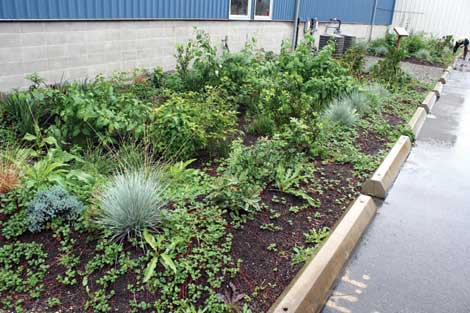What do the Port of Tacoma and the University of Washington-Tacoma have in common? Both are among a growing number of garden spots for stormwater.
Rain gardens, like the ones at the Totem Ocean Trailer Express complex at the port and the UW campus in downtown Tacoma, are gaining popularity as a way to enhance water quality by filtering pollutants out of stormwater before it reaches groundwater or local waterways.
A rain garden, as explained by the city’s Environmental Services department, is a shallow depression that’s designed and landscaped with a variety of native plants, grass and trees to catch rainwater runoff from impervious surfaces such as driveways, walkways and roofs. They can soak up and filter 100 percent of the runoff and keep it out of the city’s stormwater system, protecting aquatic life from pollution entering streams and wetlands.
Rain gardens also help prevent localized flooding and provide attractive, low-maintenance landscaping that doesn’t require chemical fertilizers – another environmental plus.
The city has developed an incentive program to encourage rain garden construction in residential areas. Homeowners living within the Flett Creek or Leach Creek watersheds can receive a rebate of $2 for each square foot of runoff that’s controlled (up to a maximum of $2,000). Elsewhere, residents could be eligible for help such as soil testing and design. More information is available at 253-591-5588.
Totem Ocean Trailer Express (TOTE), a shipping line serving Alaska, has become a prime industrial example of rain garden devotees with the three garden cells at its port facility. The gardens cleanse runoff from the 47-acre complex that otherwise could be a problem for the nearby Puyallup River watershed.
The TOTE project, finished in 2011, was led by Stewardship Partners and Rain Dog Designs in collaboration with the 12000 Rain Gardens in Puget Sound campaign. TOTE embraced the project’s potential to filter stormwater before reaching Commencement Bay in Tacoma.
According to Rain Dog, a company which has helped install 165 rain gardens in Tacoma and other Puget Sound locales in the past three years, TOTE’s installation serves as a model for others to follow, both environmentally and financially. On the latter note, a comparable sand filtration system would have cost about $240,000, officials say. The rain garden project is valued at $50,000.
At UW-Tacoma, a rain garden built on the campus by students and faculty in the university’s environmental sciences program helps put the brakes on water flowing downhill, allowing it to soak into the ground and then into the aquifer. The rain garden, which is next to a central campus stairway, reduces the amount of rainwater that could otherwise run into streets, where it could mix with oil and other pollutants from cars and sediment from non-landscaped ground.
The UW-Tacoma project was a service and learning project for students and was funded partly by the Greater Tacoma Community Foundation, which awards grants for community improvement projects.
